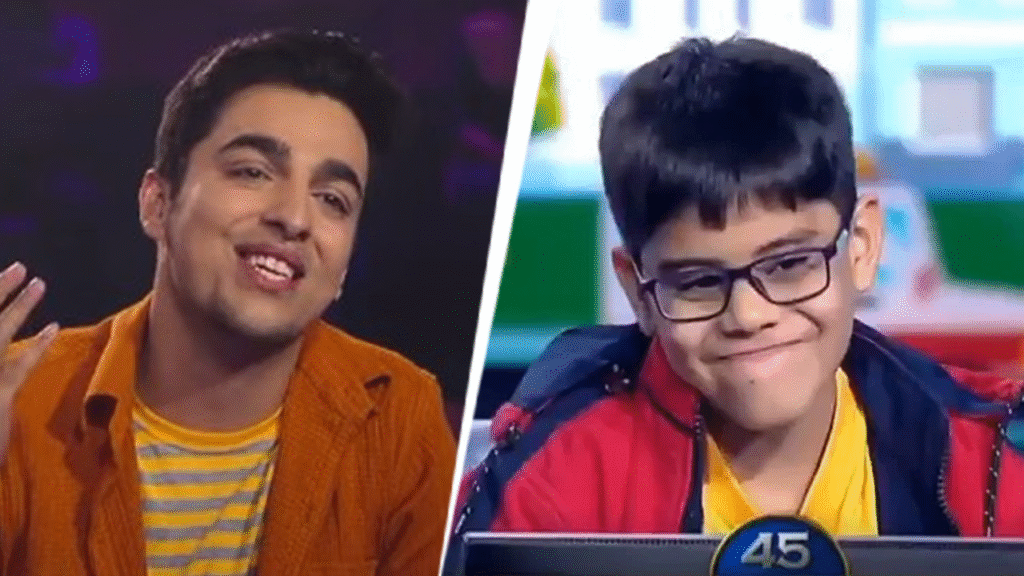What Happened: KBC kid controversy teaches us about audience behavior A ten-year-old contestant (Ishit Bhatt, fifth grade) from Gujarat was casted in a children’s version of KBC. During his onstage time, he said things like “Mere ko rules pata hai isliye aap mereko abhi rules samjhane mat baithna” (“I already know what the rules are so don’t start explaining it to me”) and kept asking the host (Amitabh Bachchan) to “give me the options” before they were read, among others.
The Times of India
The Economic Times
India Today
Because of that, the clip went viral: some people labeled the child “over-confident,” “rude,” or maybe even within the blend “disrespectful,” others put on the table the issue of what his parents did or role on television/social media to spur the reaction.
Moneycontrol
The Times of India
This leads to a bigger question around behaviour, viewers’ reaction, context and the social media response and you’ll see that manifested.
The power of viral moments of kbc kids contraversy- and what’s at stake
When something like this goes viral, a couple of dynamics are at play:
Instant Judgement and Moralising: Because the clip is short and provocative (“kid interrupts host”, “10-year-old is cocky”), many viewers arrive at loud opinions and thin context. As one article noted, “Netizens slammed…for their ‘rude’ and ‘overconfident’ behaviour.” Moneycontrol
Amplification via social media: The moment is picked up and circulated and commented on and meme’d. For example, it sparked a parenting debate and led to old KBC clips (another child losing because they over-confidently guessed) based on similar themes being shared. Indiatimes
Child contestants as lightening rods: because the contestant is a child, the dynamics shift; people prep a parent landscape, influence, pressure, and is it fair to publicly shame or ridicule a minor? e.g., singer Chinmayi Sripaada, tweeted:
“What a horrible bunch of bullies these have raised themselves to be.” India Today
Shaping narratives & framing: the media and social-media post frames the child as a “most hated kid on the internet” or “rude contestant”, and shapes public thinking, removing nuance. India Today
Moral of the Story: A viral moment often creates simplistic narratives, quick judgments, and can lose the context (age, broadcast moment, etc).
What the KBC Child Episode Shows us about Reactions on Social Media
The Kaun Banega Crorepati 17 (KBC) “kid episode” featuring 10-year-old Ishit Bhatt became an overnight social media phenomenon after his interaction with host Amitabh Bachchan that was described as confident — some even called it “rude.” Within hours, the social platforms exploded with responses. Supporters praised the child for his “bravery”; critics chastised him for his combative tone, with some even questioning his upbringing and their parental values. Something that began as innocent TV fun transformed into a nationwide debate about parenting, manners, and modern behavior.
This incident reflects the way social media allows for an amplification of emotional reactions. The online audience often enacts strong reactions based upon a few seconds of video content that provides limited information about the entire situation. An online audience — often a digital swarm — can salad the judgment, memes, or outrage from a few seconds of edited conversation. Crowds online seem to disperse outrage and quick assessments of a situation over empathy or understanding.
The KBC incident also highlights how online experiences blend entertainment and ethics. Audiences forget that behind every video is a real person that is in the video — in this case, a child. Instead of melting down in reaction, audiences need to become accustomed to pausing, considering context, and ultimately responding with kindness.
At the end of the day, the KBC moment reminds us that social media behavior is a reflection of our values, and choosing empathy over mockery is a critical focus for improving our online experience.
What this kbc kid controversy says about audience behaviour online?
Quick to critique, slow to contextualize
Many viewers quickly panned the child for “interrupting” or “telling the host what to do” and didn’t explore the elements of production, faced with the pressure of being on national television at 10-years-old, or the societal structures of the show itself:
“Why is this kid being assailed just for being a kid? Is it always a given children act according to society’s construction of ‘good behaviour’?”
The Economic Times
Mob mentality and piling on
Once a clip gets the eyes on it, and people engage in crowd behavior: comments, memes, layers of secondary commentary. Some Reddit threads express users feeling sorry for the child:
“Honestly, this is just insane. If these shows like KBC are bringing kids on the show …”
While other users participate in ridicule or moral scolding, which creates marginality and reinforces negative effects on the subject.
Disproportionately paying attention to spectacle, not substance
The spectacle (i.e. “the kid was cheeky”, “the kid went viral”) predominates over the substance (i.e. child on quiz show, parenting, editing, media accountability). Many find the sensationalism easier to digest on social media.
Children as easy targets
Because minors arguably lack agency, the public gets a kick out of criticizing children.
The interplay of production, editing and public perception about kbc kid controversy
Another facet that the KBC kid contraversy incident brings to light: production choices, editing and framing affect how a moment is seen by the public.
Reality TV & children
There is pressure on a 10-year-old to perform on a high stakes quiz show. In the case of the “KBC kid,” the child’s interactions with the host (asking for these options, attempting to lock the answer) are different enough to get noticed. The show’s format (time, emphasis, being in the spotlight) likely lends its own pressures as well.
The Economic Times
Editing selection bias either way
Any clip produced for social media is not only meant for maximum engagement but also the benefit of timing of release, predominately around the topic of children’s behaviour: “kid interrupts host,” “kid demands options with confidence,” etc. The full context (how the show seemed equipped the contestant to interact, how the host interacted, the disposition of the child) may be lacking.
Producer / network given reasons
Television programs generally enjoy viral moments—viewership, engagement, reputation are all tied to a viral moment. Some continued to excuse or insinuate the child’s behaviour was predetermined for entertainment value (courted or unconsciously) by the network or staff preparing the show. For example, some shared:
“Nowadays no one is serious for these shows…maybe one of the marketing team strategies too.”
Public expectation shaped by the social media clip
Towards more mindful digital engagement
In light of everything mentioned, what can audiences, platforms, and show-makers take away from this to enable healthier engagement?
Pause before jumping to conclusions
When you view a clip that elicits a strong response, pause and ask yourself: do I know the full context? What kind of pressures may be at work? Am I applying my expectations onto someone in a different situation (e.g. a child)?
Protect minors in the public arena
Minors on television, or social media are, by definition, susceptible to public judgment or feelings regarding their actions. Waves of public engagement are something that audience members should keep in mind when commenting on behaviours by minors, that they may not fully understand the implications of viral fame or criticism.
Extract transparency from media/production
Audience members need to know that editing and format are platforms that can change perceptions. Similarly, when production incentive structures reward virality, they are often rewarding parts of the episode where social responsibility is rendered idle.
Promote nuance, rather than sensationalism
Instead of merely memorializing a ‘viral moment’ engage in the deeper question of, what does this say about parenting culture, children and performance, social media backlash, and television’s role in modulating behaviour?
Digital behaviour and responsibility
Just because something happens on social media or online doesn’t mean it has no consequences. Trolls, harsh comments, mockery (especially directed at children) may have a lasting impact. One suggestion that…
The Viral Moment and Instant Judgment on kbc kid controversy
The episode of Kaun Banega Crorepati 17 (KBC) featuring 10-year-old contestant Ishit Bhatt likely stands as one of the most discussed viral incidents in Indian Social Media. On this edition the show catered to children. The boy, being asked a quantity of questions, told the host Amitabh Bachchan not necessary to explain anything about the game format and continued to ask for options before the host could even finish stating the question. While this may be reading defiant or cocky to some, social media immediately separated people into two equally designed camps, one condemning as “disrespectful” and one defending for being a child and just wanting to stay true to himself under a lot of pressure.
This immediate binary conflict highlights the number of people interacting with Online media without having the full context of material. Edited into a short clip with entertainment value, any moment became a national discussion about manners and parenting and “kids these days.” It also displayed how virality associates with emotionally charged responses. People comment, share, and meme moments that develop emotional attachments faster than even considering context of background or editing.
Intent or context aside, in this situation, the fun framing of the interplay turned into moral framing afterwards. The calm interaction from the host was acknowledged but at the expense of the child
Conclusion
The KBC kid controversy incident is not simply a viral moment from a TV program. It is a lens through which we can examine how audiences behave in digital spaces: how quickly we judge, how spectacle supersedes context, how children become entrapped in media-drivem loops, how production and editing shape public understanding, and how our own digital behaviour is a part of cycles of amplification, ridicule or moral outrage.
If anything, this incident call us to constraint: to view viral clips not as self-contained entertainment products, but as moments in ecosystems of production, social media, audience psychology, and culture. When we more thoughtfully engage with those ecosystem, instead of simply reactively engaging, we create space for more humane, nuanced dialogue.




